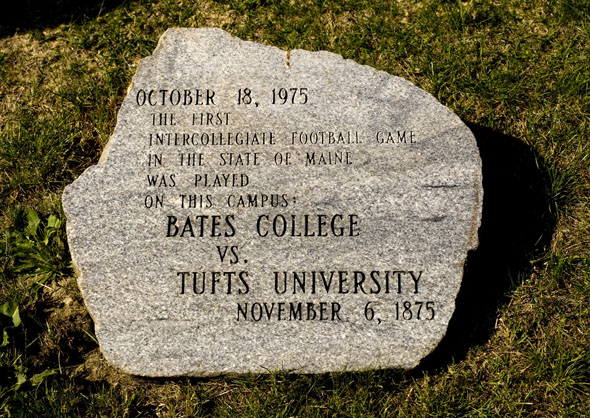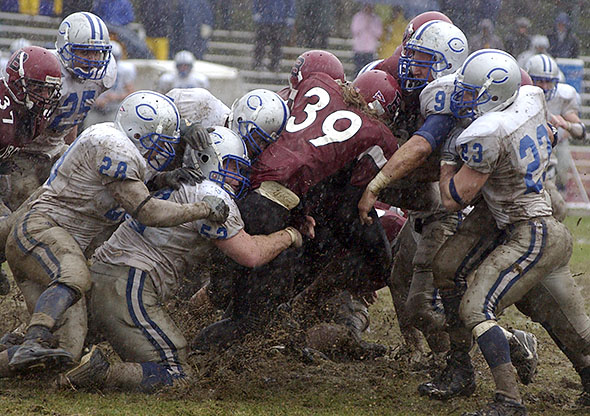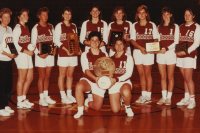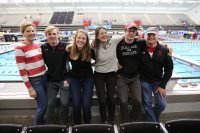Historic Garcelon Field to get FieldTurf surface among improvements
• Click the thumbnails below to view the slide show
Created in 1899 with the help of students who wielded shovels and axes to clear pastureland, historic Garcelon Field will get a major facelift this summer thanks to a similar cooperative venture, this time between the College and its donors.
Approved by the Bates Board of Trustees in May, the project will transform the natural grass football field into a FieldTurf facility by the start of the 2010–11 academic year. Lights and a new grandstand and press box will be in place by October.
A brief groundbreaking ceremony will take place at 4 p.m. on June 12 during Reunion Weekend near the south end zone of Garcelon Field, adjacent to New Commons.
In a campus announcement May 20, President Elaine Tuttle Hansen said that trustee approval depended on the project being both “fully donor-funded” and in sync with the College’s ongoing facilities planning effort, which will promises new residence halls in the Garcelon Field area in the coming years, among other long-range projects.
With $1.68 million already raised toward the $2.6 million cost of the project, trustees voted to begin construction while fundraisers work to close the remaining dollar gap.
“The Garcelon Field Project has afforded us a welcome opportunity to carry out an initiative entirely funded by donors,” Hansen wrote. (Typically, college construction projects are funded by a mix of resources that include gifts by alumni, parents and friends as one component.)
The Garcelon Field Project
http://vimeo.com/8532774 This video for the Garcelon Field Project outlines the case to restore and update the historic Bates field. Produced by Phyllis Graber Jensen.
Along with football, the new facility will be home to varsity lacrosse in the spring and provide a wet-weather site for varsity soccer in the fall. The field “will also welcome all appropriate intramural, club and informal activities, and by providing a second artificial surface, it will open up the bottleneck for practice time,” Hansen wrote.
Bates field hockey will continue to use the AstroTurf surface at Campus Avenue Field, installed in 2000.
The specific FieldTurf surface at Garcelon will be Prestige Duraspine Monofilament. Like other current-generation synthetic surfaces, FieldTurf is considered better than AstroTurf because it features synthetic grass-like blades that are cushioned, or “in-filled,” with sand and rubber granules from recycled tires.
In the 2000s, schools and colleges increasingly turned to synthetic turf fields because they could be used much more often, and retain their playability better, than natural grass fields while demanding less maintenance and no mowing or fertilizing. (The New England Patriots famously replaced their grass football surface with FieldTurf between home dates in November 2006.)
Bates becomes the fifth member of the New England Small College Athletic Conference to install FieldTurf for football, joining Trinity (2002), Middlebury (2008), Colby (2008) and Hamilton (2009). All NESCAC schools have at least one artificial turf field for one or more of their varsity programs.
“In its current condition, the old football field does not meet the standards of excellence we hope to attain in all we do at Bates.”
Since the 1980s, the Garcelon Field area has evolved from an athletics quadrant into more of a campus crossroads.
Near the football field’s north end zone is the Residential Village (1992), while Pettengill Hall (1999) is just to the west. The New Commons Building (2008) sits a few yards from the south end zone, close enough that a net protects its windows from extra-point and field goal attempts. Nearby, two historic buildings of Garcelon’s vintage, Hedge Hall (1890) and Roger Williams Hall (1895), are being renovated and expanded for new academic use.
“In its current condition, the old football field does not meet the standards of excellence we hope to attain in all we do at Bates,” Hansen wrote, and “it does not complement the state-of-the-art academic and campus life buildings in the surrounding area…. In completing that quadrant of our campus, we will further reveal to our prospective students and their families Bates’ commitment to high-quality and well-integrated facilities.”
Lewiston Sun Journal writer Kalle Oakes echoed this theme when he wrote about the project after it gained approval from the planning board. “Stuck in somewhat of a time warp, even as it rests in one of the most visible locations on campus, Garcelon Field is in line for its own facelift,” he wrote.
Garcelon Field debuted in September 1899 after a spring and summer of hard work that involved Bates students who helped to turn the “rough uncouth pasture,” in the words of The Bates Student, into an athletics complex featuring a football field, baseball diamond, quarter-mile track and tennis courts.
Forgoing their “regular recitation work,” students helped clear the land and set cedar posts around the field. Their “resulting blisters and lameness,” the Student noted, was “partially compensated for by the good things to eat and drink, served them in the society rooms by the young ladies of their respective classes.”
Garcelon Field is considered to be among the 10 oldest college football fields in the U.S., and fields at NESCAC member colleges occupy six of the top 10 spots.






